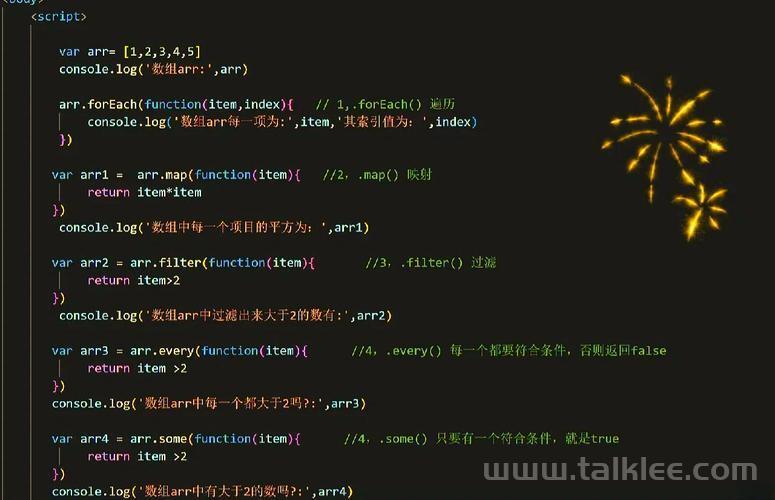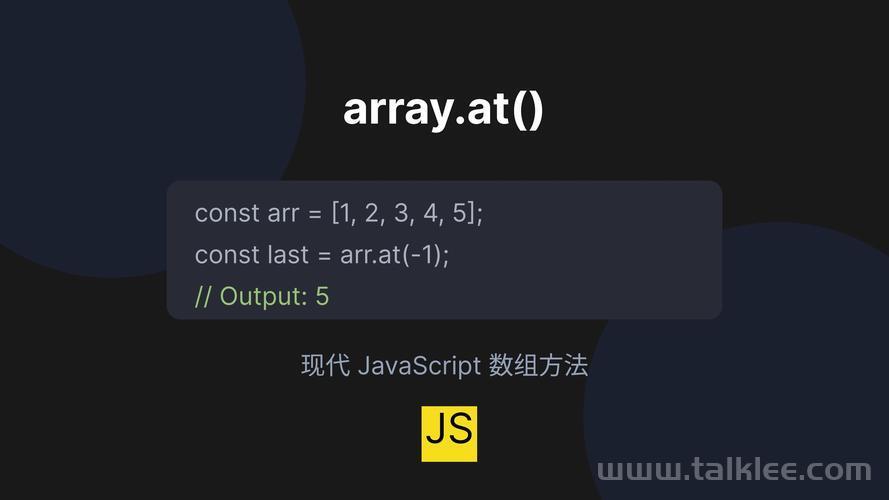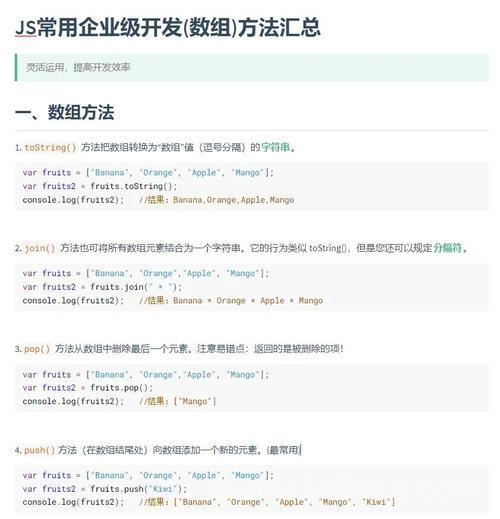前端js数组方法
一、主要的数组方法:
- join():用指定的分隔符将数组每一项拼接为字符串
- push() :向数组的末尾添加新元素
- pop():删除数组的最后一项
- shift():删除数组的第一项
- unshift():向数组首位添加新元素
- slice():按照条件查找出其中的部分元素
- splice():对数组进行增删改
- fill(): 方法能使用特定值填充数组中的一个或多个元素
- filter():“过滤”功能
- concat():用于连接两个或多个数组
- indexOf():检测当前值在数组中第一次出现的位置索引
- lastIndexOf():检测当前值在数组中最后一次出现的位置索引
- every():判断数组中每一项都是否满足条件
- some():判断数组中是否存在满足条件的项
- includes():判断一个数组是否包含一个指定的值
- sort():对数组的元素进行排序
- reverse():对数组进行倒序
- forEach():ES5 及以下循环遍历数组每一项
- map():ES6 循环遍历数组每一项
- copyWithin():用于从数组的指定位置拷贝元素到数组的另一个指定位置中
- find():返回匹配的值
- findIndex():返回匹配位置的索引
- toLocaleString()、toString():将数组转换为字符串
- flat()、flatMap():扁平化数组
- entries() 、keys() 、values():遍历数组
二、各类方法的具体使用
1.join()
在 JavaScript 里,join() 是数组对象的一个方法,其作用是把数组里的所有元素连接成一个字符串。你可以指定一个分隔符,该分隔符会被插入到数组元素之间。若不指定分隔符,默认会使用逗号 ‘,’。
语法:
arr.join([separator])
- arr:需要连接元素的数组。
- separator(可选):用于分隔数组元素的字符串。若省略该参数,数组元素会用逗号分隔。
示例:
//示例 1:使用默认分隔符 const fruits = ['Apple', 'Banana', 'Cherry']; const result = fruits.join(); console.log(result); //Apple,Banana,Cherry //示例 2:指定分隔符 const numbers = [1, 2, 3, 4, 5]; const customResult = numbers.join('-'); console.log(customResult); //1-2-3-4-5 //示例 3:使用空字符串作为分隔符 const letters = ['H', 'e', 'l', 'l', 'o']; const noSeparatorResult = letters.join(''); console.log(noSeparatorResult); //Hello2.push()
在 JavaScript 中,push() 是数组对象的一个方法,其主要作用是在数组的末尾添加一个或多个元素,并返回新数组的长度。该方法会直接修改原数组。
语法:
arr.push(element1[, ...[, elementN]])
- arr:要操作的数组。
- element1, ..., elementN:要添加到数组末尾的一个或多个元素。
示例:
// 示例 1:添加单个元素 const animals = ['dog', 'cat']; const newLength = animals.push('rabbit'); console.log('新数组长度:', newLength); console.log('更新后的数组:', animals); //新数组长度: 3 //更新后的数组: ['dog', 'cat', 'rabbit'] // 示例 2:添加多个元素 const numbers = [1, 2, 3]; const updatedLength = numbers.push(4, 5); console.log('新数组长度:', updatedLength); console.log('更新后的数组:', numbers); //新数组长度: 5 //更新后的数组: [1, 2, 3, 4, 5]3.pop()
在 JavaScript 里,pop() 是数组对象的一个方法。其作用是移除数组的最后一个元素,并且返回该被移除的元素。若数组为空,pop() 方法不会报错,而是返回 undefined,同时此方法会直接对原数组进行修改。
语法:
arr.pop()
- arr:需要操作的数组。
示例:
// 示例 1:对非空数组使用 pop() 方法 const fruits = ['apple', 'banana', 'cherry']; const removedFruit = fruits.pop(); console.log('被移除的元素:', removedFruit); console.log('更新后的数组:', fruits); //被移除的元素: cherry //更新后的数组: ['apple', 'banana'] // 示例 2:对空数组使用 pop() 方法 const emptyArray = []; const result = emptyArray.pop(); console.log('返回值:', result); console.log('数组状态:', emptyArray); //返回值: undefined //数组状态: []4.shift()
在 JavaScript 中,shift() 是数组对象的一个方法,其主要功能是移除数组的第一个元素,并返回该被移除的元素。如果数组为空,shift() 方法会返回 undefined,同时该方法会直接修改原数组。
语法:
arr.shift()
- arr:要操作的数组。
示例:
// 示例 1:对非空数组使用 shift() 方法 const colors = ['red', 'green', 'blue']; const removedColor = colors.shift(); console.log('被移除的元素:', removedColor); console.log('更新后的数组:', colors); //被移除的元素: red //更新后的数组: ['green', 'blue'] // 示例 2:对空数组使用 shift() 方法 const emptyArr = []; const result = emptyArr.shift(); console.log('返回值:', result); console.log('数组状态:', emptyArr); //返回值: undefined //数组状态: []5.unshift()
在 JavaScript 中,unshift() 是数组对象的一个方法,其作用是在数组的开头添加一个或多个元素,并返回新数组的长度。该方法会直接修改原数组。
语法:
arr.unshift(element1[, ...[, elementN]])
- arr:要操作的数组。
- element1, ..., elementN:要添加到数组开头的一个或多个元素。
示例:
(图片来源网络,侵删)// 示例 1:添加单个元素 const numbers = [2, 3, 4]; const newLength = numbers.unshift(1); console.log('新数组的长度:', newLength); console.log('更新后的数组:', numbers); //新数组的长度: 4 //更新后的数组: [1, 2, 3, 4] // 示例 2:添加多个元素 const fruits = ['banana', 'cherry']; const updatedLength = fruits.unshift('apple', 'grape'); console.log('新数组的长度:', updatedLength); console.log('更新后的数组:', fruits); //新数组的长度: 4 //更新后的数组: ['apple', 'grape', 'banana', 'cherry']6.slice()
在 JavaScript 中,slice() 是数组对象的一个方法,用于从原数组中提取出一部分元素,组成一个新的数组,而不会对原数组进行修改。
语法:
(图片来源网络,侵删)arr.slice([begin[, end]])
- arr:需要操作的数组。
- begin(可选):提取元素的起始索引位置。如果省略该参数,默认从索引 0 开始。若为负数,则表示从数组末尾开始倒数的位置,例如 -1 表示最后一个元素。
- end(可选):提取元素的结束索引位置(不包含该索引对应的元素)。如果省略该参数,会提取从 begin 到数组末尾的所有元素。若为负数,则表示从数组末尾开始倒数的位置。
示例:
// 示例 1:省略参数 const fruits = ['apple', 'banana', 'cherry', 'date', 'elderberry']; const newFruits = fruits.slice(); console.log('原数组:', fruits); console.log('新数组:', newFruits); //原数组: ['apple', 'banana', 'cherry', 'date', 'elderberry'] //新数组: ['apple', 'banana', 'cherry', 'date', 'elderberry'] // 示例 2:指定 begin 参数 const numbers = [1, 2, 3, 4, 5]; const newNumbers = numbers.slice(2); console.log('原数组:', numbers); console.log('新数组:', newNumbers); //原数组: [1, 2, 3, 4, 5] //新数组: [3, 4, 5] // 示例 3:指定 begin 和 end 参数 const animals = ['cat', 'dog', 'elephant', 'fox', 'giraffe']; const newAnimals = animals.slice(1, 3); console.log('原数组:', animals); console.log('新数组:', newAnimals); //原数组: ['cat', 'dog', 'elephant', 'fox', 'giraffe'] //新数组: ['dog', 'elephant'] // 示例 4:使用负索引 const colors = ['red', 'green', 'blue', 'yellow', 'purple']; const newColors = colors.slice(-3, -1); console.log('原数组:', colors); console.log('新数组:', newColors); //原数组: ['red', 'green', 'blue', 'yellow', 'purple'] //新数组: ['blue', 'yellow']7.fill()
在 JavaScript 中,fill() 是数组对象的一个方法,它可以用一个固定值填充数组中的一个或多个元素。该方法会直接修改原数组,并返回修改后的数组。
(图片来源网络,侵删)语法:
arr.fill(value[, start[, end]])
- arr:要操作的数组。
- value:用来填充数组元素的值。
- start(可选):开始填充的索引位置,默认为 0。如果是负数,则表示从数组末尾开始倒数的位置。
- end(可选):结束填充的索引位置(不包含该索引对应的元素),默认为数组的长度。如果是负数,则表示从数组末尾开始倒数的位置。
示例:
// 示例 1:用一个值填充整个数组 const numbers = [1, 2, 3, 4, 5]; const filledNumbers = numbers.fill(0); console.log('原数组(已被修改):', numbers); console.log('填充后返回的数组:', filledNumbers); //原数组(已被修改): [0, 0, 0, 0, 0] //填充后返回的数组: [0, 0, 0, 0, 0] // 示例 2:指定开始和结束位置进行填充 const letters = ['a', 'b', 'c', 'd', 'e']; const filledLetters = letters.fill('x', 1, 3); console.log('原数组(已被修改):', letters); console.log('填充后返回的数组:', filledLetters); //原数组(已被修改): ['a', 'x', 'x', 'd', 'e'] //填充后返回的数组: ['a', 'x', 'x', 'd', 'e'] // 示例 3:使用负索引进行填充 const colors = ['red', 'green', 'blue', 'yellow', 'purple']; const filledColors = colors.fill('orange', -2); console.log('原数组(已被修改):', colors); console.log('填充后返回的数组:', filledColors); //原数组(已被修改): ['red', 'green', 'blue', 'orange', 'orange'] //填充后返回的数组: ['red', 'green', 'blue', 'orange', 'orange']8.filter()
在 JavaScript 中,filter() 是数组对象的一个方法,其主要作用是创建一个新数组,新数组中的元素是原数组中满足指定条件的所有元素。filter() 方法不会改变原数组,而是返回一个新数组。
语法:
arr.filter(callback(element[, index[, array]])[, thisArg])
- arr:要操作的数组。
- callback:用来测试数组每个元素的函数,它接收三个参数:
- element:当前正在处理的数组元素。
- index(可选):当前元素的索引。
- array(可选):调用 filter() 方法的数组。
- thisArg(可选):执行 callback 函数时使用的 this 值
示例:
// 示例 1:筛选出数组中的偶数 const numbers = [1, 2, 3, 4, 5, 6]; const evenNumbers = numbers.filter(function (number) { return number % 2 === 0; }); console.log('原数组:', numbers); console.log('筛选出的偶数数组:', evenNumbers); //原数组: [1, 2, 3, 4, 5, 6] //筛选出的偶数数组: [2, 4, 6] // 示例 2:使用箭头函数和索引筛选元素 const words = ['apple', 'banana', 'cherry', 'date']; const longWords = words.filter((word, index) => { return word.length > 5 && index % 2 === 0; }); console.log('原数组:', words); console.log('筛选出的长单词且索引为偶数的数组:', longWords); //原数组: ['apple', 'banana', 'cherry', 'date'] //筛选出的长单词且索引为偶数的数组: ['cherry'] // 示例 3:筛选出对象数组中满足条件的对象 const users = [ { name: 'Alice', age: 25 }, { name: 'Bob', age: 30 }, { name: 'Charlie', age: 22 } ]; const adults = users.filter(user => user.age >= 25); console.log('原数组:', users); console.log('筛选出的成年人数组:', adults); //原数组: [ { name: 'Alice', age: 25 }, { name: 'Bob', age: 30 }, { name: 'Charlie', age: 22 } ] //筛选出的成年人数组: [ { name: 'Alice', age: 25 }, { name: 'Bob', age: 30 } ]9.concat()
在 JavaScript 里,concat() 是数组对象的一个方法,其用途是把两个或多个数组连接起来,形成一个新的数组。此方法不会改变原数组,而是返回一个全新的数组,该数组包含了原数组以及被连接数组的所有元素。
语法:
const newArray = oldArray.concat(value1[, value2[, ...[, valueN]]])
- oldArray:调用 concat() 方法的原始数组。
- value1, value2, ..., valueN(可选):要连接到 oldArray 末尾的数组或值。如果这些参数是数组,它们的元素会被逐个添加到新数组中;如果是其他值,则直接添加到新数组末尾。
示例:
// 示例 1:连接两个数组 const array1 = [1, 2, 3]; const array2 = [4, 5, 6]; const newArray = array1.concat(array2); console.log('原数组1:', array1); console.log('原数组2:', array2); console.log('连接后的新数组:', newArray); //原数组1: [1, 2, 3] //原数组2: [4, 5, 6] //连接后的新数组: [1, 2, 3, 4, 5, 6] // 示例 2:连接多个数组 const firstArray = ['a', 'b']; const secondArray = ['c', 'd']; const thirdArray = ['e', 'f']; const combinedArray = firstArray.concat(secondArray, thirdArray); console.log('原数组1:', firstArray); console.log('原数组2:', secondArray); console.log('原数组3:', thirdArray); console.log('连接后的新数组:', combinedArray); //原数组1: ['a', 'b'] //原数组2: ['c', 'd'] //原数组3: ['e', 'f'] //连接后的新数组: ['a', 'b', 'c', 'd', 'e', 'f'] // 示例 3:连接数组和值 const originalArray = [10, 20]; const newArrayWithValue = originalArray.concat(30, [40, 50]); console.log('原数组:', originalArray); console.log('连接后的新数组:', newArrayWithValue); //原数组: [10, 20] //连接后的新数组: [10, 20, 30, 40, 50]10.indexOf()
在 JavaScript 中,indexOf() 是数组对象的一个方法,用于查找某个指定的值在数组中首次出现的索引位置。如果该值存在于数组中,就返回它的索引;若不存在,则返回 -1。此方法进行的是严格相等比较(即 ===)。
语法:
arr.indexOf(searchElement[, fromIndex])
- arr:要进行查找操作的数组。
- searchElement:需要在数组中查找的元素。
- fromIndex(可选):开始查找的索引位置,默认值为 0。若该值为负数,则从数组末尾倒数相应位置开始查找,但查找顺序依然是从前往后。
示例:
// 示例 1:基本查找 const fruits = ['apple', 'banana', 'cherry', 'banana']; const index = fruits.indexOf('banana'); console.log('数组:', fruits); console.log('"banana" 首次出现的索引:', index); //数组: ['apple', 'banana', 'cherry', 'banana'] //"banana" 首次出现的索引: 1 // 示例 2:指定起始索引查找 const numbers = [10, 20, 30, 20, 40]; const newIndex = numbers.indexOf(20, 2); console.log('数组:', numbers); console.log('从索引 2 开始查找,"20" 首次出现的索引:', newIndex); //数组: [10, 20, 30, 20, 40] //从索引 2 开始查找,"20" 首次出现的索引: 3 // 示例 3:查找不存在的元素 const colors = ['red', 'green', 'blue']; const nonExistentIndex = colors.indexOf('yellow'); console.log('数组:', colors); console.log('"yellow" 首次出现的索引:', nonExistentIndex); //数组: ['red', 'green', 'blue'] //"yellow" 首次出现的索引: -111.lastIndexOf()
在 JavaScript 中,lastIndexOf() 是数组对象的一个方法,其主要作用是查找指定元素在数组中最后一次出现的索引位置。如果数组中存在该元素,就返回其最后一次出现的索引;若不存在,则返回 -1。该方法进行的是严格相等比较(即 ===)。
语法:
arr.lastIndexOf(searchElement[, fromIndex])
- arr:要进行查找操作的数组。
- searchElement:需要在数组中查找的元素。
- fromIndex(可选):开始反向查找的索引位置。默认值为数组的长度减 1,也就是从数组的最后一个元素开始查找。若该值为负数,则从数组末尾倒数相应位置开始反向查找。
示例:
// 示例 1:基本查找 const fruits = ['apple', 'banana', 'cherry', 'banana']; const lastIndex = fruits.lastIndexOf('banana'); console.log('数组:', fruits); console.log('"banana" 最后一次出现的索引:', lastIndex); //数组: ['apple', 'banana', 'cherry', 'banana'] //"banana" 最后一次出现的索引: 3 // 示例 2:指定起始索引查找 const numbers = [10, 20, 30, 20, 40]; const newLastIndex = numbers.lastIndexOf(20, 2); console.log('数组:', numbers); console.log('从索引 2 开始反向查找,"20" 最后一次出现的索引:', newLastIndex); //数组: [10, 20, 30, 20, 40] //从索引 2 开始反向查找,"20" 最后一次出现的索引: 1 // 示例 3:查找不存在的元素 const colors = ['red', 'green', 'blue']; const nonExistentLastIndex = colors.lastIndexOf('yellow'); console.log('数组:', colors); console.log('"yellow" 最后一次出现的索引:', nonExistentLastIndex); //数组: ['red', 'green', 'blue'] //"yellow" 最后一次出现的索引: -112.every()
在 JavaScript 里,every() 是数组对象的一个方法。它用于检测数组里的所有元素是否都满足指定的条件。该方法会对数组中的每个元素执行一次提供的测试函数,若所有元素都使测试函数返回 true,则 every() 方法返回 true;只要有一个元素使测试函数返回 false,就会立即停止遍历并返回 false。此方法不会改变原数组。
语法:
arr.every(callback(element[, index[, array]])[, thisArg])
- arr:要进行检测的数组。
- callback:用来测试每个元素的函数,它接收三个参数:
- element:当前正在处理的数组元素。
- index(可选):当前元素的索引。
- array(可选):调用 every() 方法的数组。
- thisArg(可选):执行 callback 函数时使用的 this 值。
示例:
// 示例 1:检查数组中的所有元素是否都大于 0 const numbers = [1, 2, 3, 4, 5]; const allPositive = numbers.every(function (number) { return number > 0; }); console.log('数组:', numbers); console.log('数组中的所有元素是否都大于 0:', allPositive); //数组: [1, 2, 3, 4, 5] //数组中的所有元素是否都大于 0: true // 示例 2:使用箭头函数检查数组中的所有元素长度是否都大于 3 const words = ['apple', 'banana', 'cherry']; const allLongWords = words.every(word => word.length > 3); console.log('数组:', words); console.log('数组中的所有元素长度是否都大于 3:', allLongWords); //数组: ['apple', 'banana', 'cherry'] //数组中的所有元素长度是否都大于 3: true // 示例 3:检查数组中的所有元素是否都是偶数 const mixedNumbers = [2, 4, 6, 7]; const allEven = mixedNumbers.every(num => num % 2 === 0); console.log('数组:', mixedNumbers); console.log('数组中的所有元素是否都是偶数:', allEven); //数组: [2, 4, 6, 7] //数组中的所有元素是否都是偶数: false13.some()
在 JavaScript 中,some() 是数组对象的一个方法,用于检测数组中是否至少有一个元素满足指定的条件。它会对数组中的每个元素依次执行你提供的测试函数,只要有一个元素使测试函数返回 true,some() 方法就会立即返回 true;若所有元素都使测试函数返回 false,则 some() 方法返回 false。此方法不会改变原数组。
语法:
arr.some(callback(element[, index[, array]])[, thisArg])
- arr:要进行检测的数组。
- callback:用于测试每个元素的函数,该函数接收三个参数:
- element:当前正在处理的数组元素。
- index(可选):当前元素的索引。
- array(可选):调用 some() 方法的数组。
- thisArg(可选):执行 callback 函数时使用的 this 值。
示例:
// 示例 1:检查数组中是否有元素大于 5 const numbers = [1, 3, 7, 4]; const hasGreaterThanFive = numbers.some(function (number) { return number > 5; }); console.log('数组:', numbers); console.log('数组中是否有元素大于 5:', hasGreaterThanFive); //数组: [1, 3, 7, 4] //数组中是否有元素大于 5: true // 示例 2:使用箭头函数检查数组中是否有元素长度小于 3 const words = ['apple', 'cat', 'banana']; const hasShortWord = words.some(word => word.length num % 2 === 0); console.log('数组:', mixedNumbers); console.log('数组中是否有偶数:', hasEvenNumber); //数组: [1, 3, 5, 8] //数组中是否有偶数: true14.includes()
在 JavaScript 里,includes() 是数组对象的一个方法,它用于判断数组是否包含某个指定的值。若包含则返回 true,不包含则返回 false。此方法进行的是严格相等比较(即 ===),并且可以指定从哪个索引位置开始查找。
语法:
arr.includes(valueToFind[, fromIndex])
- arr:要进行检查的数组。
- valueToFind:需要在数组中查找的值。
- fromIndex(可选):开始查找的索引位置,默认值为 0。若该值为负数,则从数组末尾倒数相应位置开始查找,但查找顺序依然是从前往后。若 fromIndex 的绝对值大于数组长度,会直接从索引 0 开始查找。
示例:
// 示例 1:基本查找 const fruits = ['apple', 'banana', 'cherry']; const hasBanana = fruits.includes('banana'); console.log('数组:', fruits); console.log('数组中是否包含 "banana":', hasBanana); //数组: ['apple', 'banana', 'cherry'] //数组中是否包含 "banana": true // 示例 2:指定起始索引查找 const numbers = [10, 20, 30, 20]; const hasTwentyFromIndexTwo = numbers.includes(20, 2); console.log('数组:', numbers); console.log('从索引 2 开始查找,数组中是否包含 "20":', hasTwentyFromIndexTwo); //数组: [10, 20, 30, 20] //从索引 2 开始查找,数组中是否包含 "20": true // 示例 3:查找不存在的元素 const colors = ['red', 'green', 'blue']; const hasYellow = colors.includes('yellow'); console.log('数组:', colors); console.log('数组中是否包含 "yellow":', hasYellow); //数组: ['red', 'green', 'blue'] //数组中是否包含 "yellow": false // 示例 4:使用负索引查找 const letters = ['a', 'b', 'c', 'd']; const hasBFromNegativeIndex = letters.includes('b', -3); console.log('数组:', letters); console.log('从倒数第 3 个位置开始查找,数组中是否包含 "b":', hasBFromNegativeIndex); //数组: ['a', 'b', 'c', 'd'] //从倒数第 3 个位置开始查找,数组中是否包含 "b": true15.sort()
在 JavaScript 中,sort() 是数组对象的一个方法,用于对数组的元素进行排序。默认情况下,sort() 方法会将数组元素转换为字符串,然后按照 Unicode 编码顺序进行排序。这意味着如果直接对数字数组使用 sort() 方法,可能无法得到预期的数字大小排序结果。不过,你可以通过传入一个比较函数来定义自定义的排序规则。sort() 方法会直接修改原数组,并返回排序后的数组。
语法:
arr.sort([compareFunction])
- arr:要进行排序的数组。
- compareFunction(可选):用于定义排序规则的比较函数。该函数接收两个参数 a 和 b,表示数组中的两个元素,根据返回值的正负来决定元素的排序顺序:
- 如果返回值小于 0,则 a 会被排列到 b 之前。
- 如果返回值等于 0,则 a 和 b 的相对位置不变。
- 如果返回值大于 0,则 b 会被排列到 a 之前。
示例:
// 示例 1:默认排序(按 Unicode 编码顺序) const fruits = ['banana', 'apple', 'cherry']; const sortedFruits = fruits.sort(); console.log('原数组(已被修改):', fruits); console.log('排序后返回的数组:', sortedFruits); //原数组(已被修改): ['apple', 'banana', 'cherry'] //排序后返回的数组: ['apple', 'banana', 'cherry'] // 示例 2:对数字数组使用默认排序 const numbers = [10, 5, 2, 20]; const defaultSortedNumbers = numbers.sort(); console.log('原数组(已被修改):', numbers); console.log('默认排序后返回的数组:', defaultSortedNumbers); //原数组(已被修改): [10, 2, 20, 5] //默认排序后返回的数组: [10, 2, 20, 5] // 示例 3:使用比较函数对数字数组进行升序排序 const newNumbers = [10, 5, 2, 20]; const ascendingSortedNumbers = newNumbers.sort((a, b) => a - b); console.log('原数组(已被修改):', newNumbers); console.log('升序排序后返回的数组:', ascendingSortedNumbers); //原数组(已被修改): [2, 5, 10, 20] //升序排序后返回的数组: [2, 5, 10, 20] // 示例 4:使用比较函数对数字数组进行降序排序 const anotherNumbers = [10, 5, 2, 20]; const descendingSortedNumbers = anotherNumbers.sort((a, b) => b - a); console.log('原数组(已被修改):', anotherNumbers); console.log('降序排序后返回的数组:', descendingSortedNumbers); //原数组(已被修改): [20, 10, 5, 2] //降序排序后返回的数组: [20, 10, 5, 2]16.reverse()
在 JavaScript 中,reverse() 是数组对象的一个方法,其主要功能是颠倒数组中元素的顺序。该方法会直接修改原数组,将数组元素的排列顺序反转,最后返回修改后的原数组
语法:
arr.reverse()
- arr:要进行元素顺序颠倒操作的数组。
示例:
// 示例 1:对普通数组使用 reverse() 方法 const numbers = [1, 2, 3, 4, 5]; const reversedNumbers = numbers.reverse(); console.log('原数组(已被修改):', numbers); console.log('反转后返回的数组:', reversedNumbers); //原数组(已被修改): [5, 4, 3, 2, 1] //反转后返回的数组: [5, 4, 3, 2, 1] // 示例 2:对字符串数组使用 reverse() 方法 const fruits = ['apple', 'banana', 'cherry']; const reversedFruits = fruits.reverse(); console.log('原数组(已被修改):', fruits); console.log('反转后返回的数组:', reversedFruits); //原数组(已被修改): ['cherry', 'banana', 'apple'] //反转后返回的数组: ['cherry', 'banana', 'apple']17.forEach()
在 JavaScript 里,forEach() 是数组对象的一个方法,它用于对数组的每个元素执行一次提供的函数。forEach() 方法没有返回值,其主要目的是遍历数组元素并对每个元素执行特定操作。这个方法为数组中的每个元素依次调用一次你提供的回调函数,并且不会改变原数组。
语法:
arr.forEach(callback(currentValue[, index[, array]])[, thisArg])
- arr:要进行遍历的数组。
- callback:为数组中每个元素执行的函数,该函数接收三个参数:
- currentValue:当前正在处理的数组元素。
- index(可选):当前元素的索引。
- array(可选):调用 forEach() 方法的数组。
- thisArg(可选):执行 callback 函数时使用的 this 值。
示例:
// 示例 1:简单遍历数组并打印元素 const numbers = [1, 2, 3, 4, 5]; numbers.forEach(function (number) { console.log(number); }); //1 //2 //3 //4 //5 // 示例 2:使用索引和数组参数 const fruits = ['apple', 'banana', 'cherry']; fruits.forEach(function (fruit, index, array) { console.log(`索引 ${index} 处的元素是 ${fruit},数组是 ${array}`); }); //索引 0 处的元素是 apple,数组是 apple,banana,cherry //索引 1 处的元素是 banana,数组是 apple,banana,cherry //索引 2 处的元素是 cherry,数组是 apple,banana,cherry // 示例 3:使用箭头函数和累加操作 let sum = 0; const newNumbers = [10, 20, 30]; newNumbers.forEach((number) => { sum += number; }); console.log('数组元素的总和是:', sum); //数组元素的总和是: 6018.map()
在 JavaScript 中,map() 是数组对象的一个方法,它用于创建一个新数组,新数组中的元素是原数组中每个元素经过指定函数处理后的结果。也就是说,map() 方法会对原数组的每个元素依次调用你提供的回调函数,并将回调函数的返回值作为新数组对应位置的元素。该方法不会改变原数组。
语法:
arr.map(callback(currentValue[, index[, array]])[, thisArg])
- arr:要进行操作的原数组。
- callback:为数组中每个元素执行的函数,该函数接收三个参数:
- currentValue:当前正在处理的数组元素。
- index(可选):当前元素的索引。
- array(可选):调用 map() 方法的数组。
- thisArg(可选):执行 callback 函数时使用的 this 值。
示例:
// 示例 1:将数组中的每个元素乘以 2 const numbers = [1, 2, 3, 4, 5]; const doubledNumbers = numbers.map(function (number) { return number * 2; }); console.log('原数组:', numbers); console.log('新数组(每个元素乘以 2):', doubledNumbers); //原数组: [1, 2, 3, 4, 5] //新数组(每个元素乘以 2): [2, 4, 6, 8, 10] // 示例 2:使用箭头函数和索引参数 const names = ['Alice', 'Bob', 'Charlie']; const nameWithIndex = names.map((name, index) => `${index + 1}. ${name}`); console.log('原数组:', names); console.log('新数组(添加索引):', nameWithIndex); //原数组: ['Alice', 'Bob', 'Charlie'] //新数组(添加索引): ['1. Alice', '2. Bob', '3. Charlie'] // 示例 3:处理对象数组 const users = [ { name: 'Alice', age: 25 }, { name: 'Bob', age: 30 }, { name: 'Charlie', age: 22 } ]; const userAges = users.map(user => user.age); console.log('原数组:', users); console.log('新数组(只包含年龄):', userAges); //原数组: [ { name: 'Alice', age: 25 }, { name: 'Bob', age: 30 }, { name: 'Charlie', age: 22 } ] //新数组(只包含年龄): [25, 30, 22]19.copyWithin()
在 JavaScript 中,copyWithin() 是数组对象的一个方法,它用于在数组内部将指定位置的元素复制到其他位置(覆盖原有元素),并返回修改后的原数组。该方法会直接修改原数组,不会改变数组的长度。
语法:
arr.copyWithin(target[, start[, end]])
- arr:要进行操作的数组。
- target:复制序列到该位置。如果是负数,target 将从数组末尾开始计算。
- start(可选):开始复制元素的起始位置。默认值为 0。如果是负数,start 将从数组末尾开始计算。
- end(可选):停止复制元素的结束位置(不包含该位置的元素)。默认值为数组的长度。如果是负数,end 将从数组末尾开始计算。
示例:
// 示例 1:简单复制 const numbers = [1, 2, 3, 4, 5]; // 从索引 0 开始复制元素,复制到索引 3 的位置 const result = numbers.copyWithin(3); console.log('修改后的数组:', result); //修改后的数组: [1, 2, 3, 1, 2] // 示例 2:指定起始和结束位置复制 const letters = ['a', 'b', 'c', 'd', 'e']; // 从索引 1 开始复制元素,到索引 3 停止复制,复制到索引 0 的位置 const newResult = letters.copyWithin(0, 1, 3); console.log('修改后的数组:', newResult); //修改后的数组: ['b', 'c', 'c', 'd', 'e'] // 示例 3:使用负索引复制 const colors = ['red', 'green', 'blue', 'yellow', 'purple']; // 从倒数第 2 个元素开始复制,复制到倒数第 4 个元素的位置 const finalResult = colors.copyWithin(-4, -2); console.log('修改后的数组:', finalResult); //修改后的数组: ['red', 'yellow', 'purple', 'yellow', 'purple']20.find()
在 JavaScript 中,find() 是数组对象的一个方法,它用于查找数组中满足指定条件的第一个元素。该方法会对数组中的每个元素依次执行你提供的测试函数,一旦某个元素使测试函数返回 true,find() 方法就会立即返回该元素;如果数组中没有元素能使测试函数返回 true,则返回 undefined。find() 方法不会改变原数组。
语法:
arr.find(callback(element[, index[, array]])[, thisArg])
- arr:要进行查找操作的数组。
- callback:用于测试每个元素的函数,该函数接收三个参数:
- element:当前正在处理的数组元素。
- index(可选):当前元素的索引。
- array(可选):调用 find() 方法的数组。
- thisArg(可选):执行 callback 函数时使用的 this 值。
示例:
// 示例 1:查找数组中第一个大于 5 的元素 const numbers = [1, 3, 7, 4, 9]; const firstGreaterThanFive = numbers.find(function (number) { return number > 5; }); console.log('数组:', numbers); console.log('数组中第一个大于 5 的元素:', firstGreaterThanFive); //数组: [1, 3, 7, 4, 9] //数组中第一个大于 5 的元素: 7 // 示例 2:使用箭头函数查找对象数组中年龄大于 25 的第一个用户 const users = [ { name: 'Alice', age: 22 }, { name: 'Bob', age: 28 }, { name: 'Charlie', age: 20 } ]; const firstUserOver25 = users.find(user => user.age > 25); console.log('数组:', users); console.log('数组中年龄大于 25 的第一个用户:', firstUserOver25); //数组: [ { name: 'Alice', age: 22 }, { name: 'Bob', age: 28 }, { name: 'Charlie', age: 20 } ] //数组中年龄大于 25 的第一个用户: { name: 'Bob', age: 28 } // 示例 3:查找不存在的元素 const letters = ['a', 'b', 'c']; const nonExistentElement = letters.find(letter => letter === 'd'); console.log('数组:', letters); console.log('查找结果:', nonExistentElement); //数组: ['a', 'b', 'c'] //查找结果: undefined21.findIndex()
在 JavaScript 中,findIndex() 是数组对象的一个方法,其作用是查找数组中满足指定条件的第一个元素的索引。它会对数组中的每个元素依次执行你提供的测试函数,一旦某个元素使测试函数返回 true,findIndex() 方法就会立即返回该元素的索引;若数组中没有元素能使测试函数返回 true,则返回 -1。此方法不会改变原数组。
语法:
- arr:要进行查找操作的数组。
- callback:用于测试每个元素的函数,该函数接收三个参数:
- element:当前正在处理的数组元素。
- index(可选):当前元素的索引。
- array(可选):调用 findIndex() 方法的数组。
- thisArg(可选):执行 callback 函数时使用的 this 值。
示例:
// 示例 1:查找数组中第一个大于 10 的元素的索引 const numbers = [5, 8, 12, 3, 15]; const index = numbers.findIndex(function (number) { return number > 10; }); console.log('数组:', numbers); console.log('数组中第一个大于 10 的元素的索引:', index); //数组: [5, 8, 12, 3, 15] //数组中第一个大于 10 的元素的索引: 2 // 示例 2:使用箭头函数查找对象数组中年龄大于 25 的第一个用户的索引 const users = [ { name: 'Alice', age: 22 }, { name: 'Bob', age: 28 }, { name: 'Charlie', age: 20 } ]; const userIndex = users.findIndex(user => user.age > 25); console.log('数组:', users); console.log('数组中年龄大于 25 的第一个用户的索引:', userIndex); //数组: [ { name: 'Alice', age: 22 }, { name: 'Bob', age: 28 }, { name: 'Charlie', age: 20 } ] //数组中年龄大于 25 的第一个用户的索引: 1 // 示例 3:查找不存在的元素的索引 const letters = ['a', 'b', 'c']; const nonExistentIndex = letters.findIndex(letter => letter === 'd'); console.log('数组:', letters); console.log('查找结果:', nonExistentIndex); //数组: ['a', 'b', 'c'] //查找结果: -1
- arr:要进行元素顺序颠倒操作的数组。
- arr:要操作的数组。
- arr:需要操作的数组。







